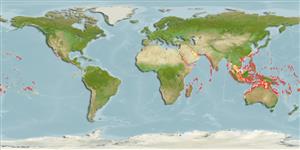>
Gobiiformes (Gobies) >
Gobiidae (Gobies) > Gobionellinae
Etymology: Gnatholepis: Greek, gnathos = jaw + Greek,lepis = scale (Ref. 45335); cauerensis: Named for the southern location of the islands in southeastern Oceania where the species is found..
More on author: Bleeker.
Environment: milieu / climate zone / depth range / distribution range
экология
морской; солоноватоводный ассоциированный с рифами; пределы глубины 2 - 50 m (Ref. 90102), usually 2 - 20 m (Ref. 27115). Tropical; 30°N - 28°S
Indo-Pacific: widespread from South Africa to Pitcairn I.; in the Pacific north to Miyake-jima, Japan, south to Sydney Harbour, Australia; in the Indian Ocean north to Djibouti (Gulf of Tadjourah) and south to Aliwal Shoal, Kwa-Zulu Natal.
Size / Вес / Возраст
Maturity: Lm ? range ? - ? cm
Max length : 6.0 cm SL самец/пол неопределен; (Ref. 48637)
колючие лучи спинного плавника (общее число): 7; членистые (мягкие) лучи спинного плавника (общее число): 11; колючие лучи анального плавника 1; членистые (мягкие) лучи анального плавника: 11. Distinguished by the following characteristics: moderate-sized (up to 56 mm SL) with wide range in live colour pattern; ctenoid body scales usually reaching rear corner of opercle, occasionally ctenoid scales reaching to above rear preopercular margin; nape midline scales always cycloid, distinct flap present at end of lower lip; when alive, colour variable: body translucent white with five to seven rows of small variably coloured (dull orange, brown, red-brown to blackish) spots and/or thin lines and about six indistinct diffuse orange-brown to purple-brown blotches along midside; narrow vertical black mark on top of each eye, marks may join each other across interorbital space, and narrow black vertical line crossing cheek below eye; small dark mark of variable shape (often W-shaped) above pectoral fin base, with small yellow spot in centre; second dorsal and anal fin rays usually I,11; pectoral rays 12-18, modally 16; lateral scales 24-30, modally 27; 7-12 predorsal scales (modally 9) (Ref. 92171).
A common species that occurs in sheltered sandy areas from reef flats to seaward reefs; over sandy bottoms near pieces of rubble, rock, or coral (live or dead) (Ref. 9710, 48637, 92171). Solitary or in small groups (Ref. 90102). Feeds on algae, detritus and small benthic invertebrates (Ref. 89972).
Life cycle and mating behavior
половая зрелость | размножение | нерест | икра | Fecundity | личинки
Larson, H.K. and D.J. Buckle, 2012. A revision of the goby genus Gnatholepis Bleeker (Teleostei, Gobiidae, Gobionellinae), with description of a new species. Zootaxa 3529:1-69. (Ref. 92171)
Статус Красного Списка МСОП (Ref. 130435)
Угроза для людей
Harmless
Использование человеком
аквариум: коммерческий
дополнительная информация
ссылкиаквакультура (рыбоводство)особенности рыбоводствастепень растяжениягенетикаElectrophoresesнаследуемостьболезниобработкаNutrientsMass conversion
инструменты
Специальные отчеты
Скачать в формате XML
ресурсы в Интернет
Estimates based on models
Preferred temperature (Ref.
123201): 24.7 - 28.9, mean 27.6 °C (based on 774 cells).
Phylogenetic diversity index (Ref.
82804): PD
50 = 0.5010 [Uniqueness, from 0.5 = low to 2.0 = high].
Bayesian length-weight: a=0.00977 (0.00442 - 0.02163), b=3.05 (2.86 - 3.24), in cm total length, based on LWR estimates for this (Sub)family-body shape (Ref.
93245).
Trophic level (Ref.
69278): 2.3 ±0.0 se; based on diet studies.
устойчивость к внешним воздействиям (Ref.
120179): высокий, минимальное время удвоения популяции до 15 месяцев (Preliminary K or Fecundity.).
Fishing Vulnerability (Ref.
59153): Low vulnerability (10 of 100).
Nutrients (Ref.
124155): Calcium = 173 [83, 398] mg/100g; Iron = 1.01 [0.47, 1.99] mg/100g; Protein = 18.2 [16.2, 19.9] %; Omega3 = 0.164 [0.069, 0.322] g/100g; Selenium = 23.8 [11.4, 62.9] μg/100g; VitaminA = 122 [29, 448] μg/100g; Zinc = 3.25 [2.10, 4.97] mg/100g (wet weight);
